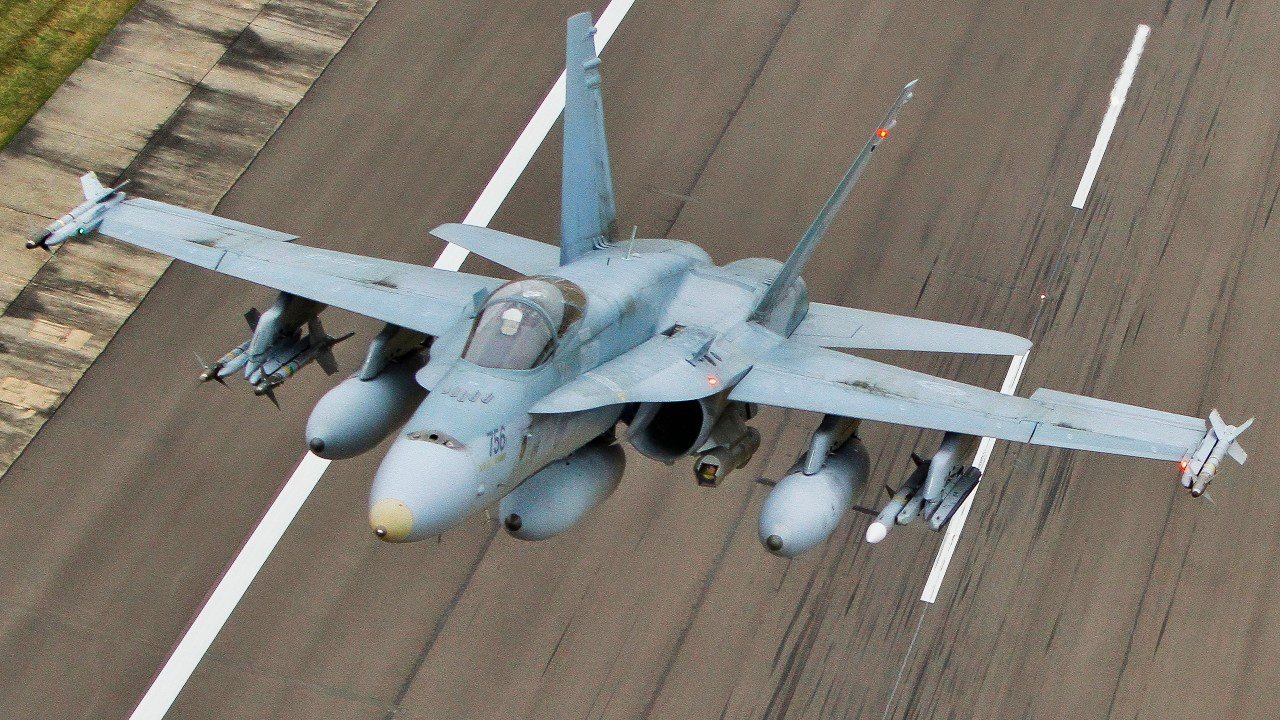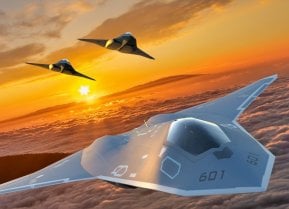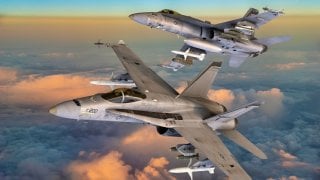The End is Near for the U.S. Navy's F/A-18 Super Hornet
The end of production of the F/A-18 won't actually mean an end to the program. The Super Hornet, an upgraded, enlarged, and improved version of the F/A-18 Hornet, first entered service in 1999. It has remained the workhorse for the U.S. Navy for a quarter century, and those final Super Hornets will likely be flying for decades to come as well.
Summary: The U.S. Navy's F/A-18 Super Hornets, showcased in recent airstrikes from the USS Dwight D. Eisenhower, underscore their enduring relevance despite approaching the twilight of their production. Boeing's $1.3 billion contract for 17 new Super Hornets marks a potential end to the production line post-2027, amidst struggles to secure additional buyers. While production rates will decelerate, Boeing plans no layoffs, transitioning its workforce towards other projects like the F-15EX and MQ-25. The F/A-18's journey, however, is far from over. Upgrades to the Block III variant promise enhanced capabilities, ensuring these jets remain a naval staple into the 2040s. This enduring commitment underscores the Super Hornet's pivotal role in U.S. naval aviation, blending legacy with modernization to maintain strategic dominance.
RIP: F/A-18 Super Hornet?
Earlier this year, U.S. Navy F/A-18 Super Hornets carried out airstrikes on Houthi positions in Yemen, carried from the aircraft carrier, the USS Dwight D. Eisenhower (CVN-69). It served as a reminder that the Super Hornet still has quite the sting.
Yet, the aircraft is beginning to approach its end of life – and the emphasis is still on "beginning." That is because while Boeing continues to run the production line for the carrier-based multirole attack aircraft, the production could cease after 2027. The aerospace giant secured a new $1.3 billion U.S. Navy contract for 17 new Super Hornets – after months of tense negotiations on the price for the twin-engine aircraft – but Boeing has failed in finding additional customers.
"We ran a number of international campaigns or competitions that we were unsuccessful in previous years," Mark Sears, Boeing vice president for fighters, said in an interview with Breaking Defense. "Those kind of played out and there are no active discussions with the Navy about additional F-18s beyond these."
The aircraft maker will slow down its build rate of two jets per month to just one and a half, while it pivots its St. Louis Super Hornet workforce towards other Boeing programs – including the F-15EX, T-7A trainer, and MQ-25 refueling. Sears added that Boeing is actually increasing its workforce at the site, and doesn't expect to see the need for layoffs even once production of the F/A-18 Super Hornet winds down.
"Slowing down can be just as hard as speeding up, frankly, in the production space. We know there are challenges ahead for us in delivering these airplanes," Sears continued.
Sunset For the F/A-18 Super Hornet – Not Quite Yet
The end of production of the F/A-18 won't actually mean an end to the program. The Super Hornet, an upgraded, enlarged, and improved version of the F/A-18 Hornet, first entered service in 1999. It has remained the workhorse for the U.S. Navy for a quarter century, and those final Super Hornets will likely be flying for decades to come as well.
In addition, existing F/A-18 Super Hornets in the fleet will be upgraded to the Block III version, with progress to be completed by 2030.
Delivery of the final 17 Block III aircraft is expected to begin in winter 2026 and reach completion in the spring of 2027, according to Naval Air System Command. As noted, the contract was valued at $1.3 billion and will include a technical data package that is described as vital to the sustainment of the platform.
"The technical data package was a crucial part of this negotiation; It is necessary for naval aviation’s operational readiness and postproduction sustainment," said Rear Admiral John Lemmon, program executive officer for tactical aircraft programs, last month when the deal was announced. "The Super Hornet remains a predominant aircraft in the carrier air wing and will continue to provide significant combat capability into the 2040s."
The U.S. Navy received appropriated funds from Congress to purchase the block of F/A-18 Super Hornets – the larger and more advanced version of the original F/A-18 Hornet carrier-capable, multirole fighter – to help mitigate the strike fighter shortfall. The award is an Undefinitized Contract Action with the intent to definitize within the next few months.
The F/A-18 Super Hornet in the Spotlight
The F/A-18 E/F Super Hornet, which is now manufactured by Boeing following its merger with McDonnell Douglas in 1997, has been produced in two distinct versions including the single-seat F/A-18/E and the dual-seat F/A-18/F. The advanced aircraft entered fleet service in 1999, as the replacement for the F-14 Tomcat.
It marked the second major model upgrade since the inception of the F/A-18 aircraft program highly capable across the full mission spectrum: air superiority, fighter escort, reconnaissance, aerial refueling, close air support, air defense suppression, and day/night precision strike. The single-seat F/A-18E and the two-seat F/A-18F are high-performance, twin-engine, mid-wing, and multi-mission tactical aircraft designed to replace the F/A-18C (single-seat) and F/A-18D (two-seat) aircraft as they reach the end of their service lives and retire.
As the final variants of the original multirole F/A-18 aircraft, the model offered a 20 percent larger airframe, while the Super Hornet could carry an additional 33 percent more internal fuel, which increased its mission range by 41 percent while its endurance was increased by 50 percent over the earlier aircraft. Yet, despite being super-sized, the F/A-18E/F actually has 42 percent fewer parts than its predecessor the F/A-18C/D variant.

Multirole and More
The Super Hornet has performed as a multirole attack aircraft via the use of different external equipment, while the fighter jet's advanced networking capabilities have allowed it to accomplish very specific missions. In this way, it has been utilized as a "force multiplier" where it has been deployed to meet the various challenges that a carrier might face. In its fighter mode, it has served as an escort and provided fleet air defenses from enemy aircraft and other threats; while in its attack mode, it has provided force projection, interdiction, and close and deep air support.
The F/A-18E/F continues to meet current Navy fighter escort and interdiction mission requirements and has been employed in an increasing range of missions, including Forward Air Controller (Airborne) and Aerial Tanking, as they have proven capability to replace the S-3 as an aerial tanker. F/A-18E/F enhancements include increased range and improved carrier suitability required for the F/A-18 to continue its key strike fighter role against the advanced threats of the 21st century.
The latest Block III upgrade, which is currently undergoing test and evaluation, will extend the platform's service life and range and incorporates an advanced cockpit system, reduced radar cross section, and an advanced networking infrastructure. The Boeing Company delivered two F/A-18 Block III Super Hornet test jets to the U.S. Navy in June 2020, with production to follow successful testing and a contract in place to provide 78 new-build F/A-18 Block III jets to the Service through the rest of this year.
The U.S. Navy's Blue Angels Flight Demonstration Squadron, which had flown the F/A-18 Hornet since 1986, began the transition to the F/A-18 Super Hornet in 2020.
Author Experience and Expertise: Peter Suciu
Peter Suciu is a Michigan-based writer. He has contributed to more than four dozen magazines, newspapers, and websites with over 3,200 published pieces over a twenty-year career in journalism. He regularly writes about military hardware, firearms history, cybersecurity, politics, and international affairs. Peter is also a Contributing Writer for Forbes and Clearance Jobs. You can follow him on Twitter: @PeterSuciu.
You can email the author: [email protected].
Image Credit: Shutterstock.


